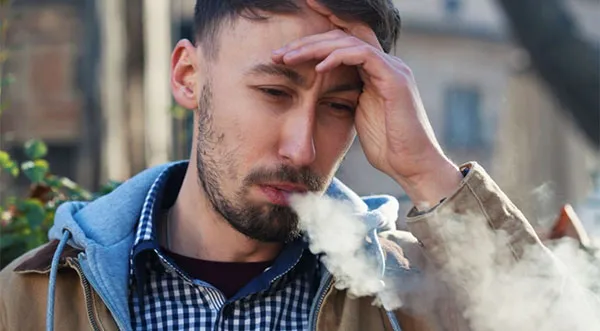6 Ways to Get Rid of Vape Headache Fast (Causes & Prevention)

30 May 2024
Vaping, while often marketed as a safer alternative to traditional smoking, is not without its own set of challenges. One such issue that many vapers face is the occurrence of headaches.
Vaping headaches can range from mild to severe. However, most common side effects are dry mouth, increased anxiety, insomnia, cough, throat irritation, lightheadedness, and shortness of breath.
Headaches while or after vaping may occur due to multiple reasons. It may occur due to high nicotine content, certain chemicals in e-liquids, and dehydration.
What Does a Vaping Headache Feel Like?
Like other types of headaches, a vaping headache can vary in its specific characteristics from person to person. However, some common symptoms associated with vaping headaches include:
- Throbbing or Pulsating Pain: The vape headaches may have a rhythmic or pulsating sensation — people often describe it as a throbbing pain.
- Location of Pain: The pain can be local to specific areas of the head, such as the temples, forehead, back of the head, or more general.
- Intensity: The headache can range from mild to moderate, although in some cases, it may be severe. The intensity can vary, even between episodes.
- Pressure or Tightness: Many individuals experience a sensation of pressure or tightness in their forehead, temples, or the back of their head.
- Additional Symptoms: Some people may experience additional symptoms alongside the headache, such as sensitivity to light (photophobia), sensitivity to sound (phonophobia), nausea, or vomiting.
Why Does Vape Cause a Headache?

Vaping can cause severe headaches for several reasons:
Nicotine:
Many e-cigarettes and vaping devices contain nicotine, a stimulant. Nicotine can cause vasoconstriction, which is the narrowing of blood vessels, and alter blood flow.
As a result, changes in blood flow result in nicotine headaches, which may lead to migraines. Some people may also have nicotine withdrawal systems if they are addicted to it, which also results in nasty headaches.
Dehydration:
Vaping can contribute to dehydration, especially if it leads to increased thirst or the user does not consume enough fluids while vaping. Dehydration is a known trigger for frequent headaches in some people.
Sensitivity to Chemicals:
Some people may be more sensitive to the chemicals and additives in e-liquids, such as propylene glycol or vegetable glycerin, flavorings, or other ingredients. These substances can potentially trigger headaches or migraines.
How to stop headaches from vaping?

If you’re experiencing a vape headache, here are six ways to get rid of it quickly:
Hydrate:
Dehydration is a known trigger for headaches. Vaping can contribute to dehydration, especially if it leads to increased thirst or the user does not consume enough fluids while vaping. So, drink plenty of water throughout the day – aim for at least 8-10 glasses.
Rest:
Sometimes, all your body needs is a bit of rest. Try lying down in a quiet, dark room. This can help to alleviate the symptoms of a headache.
Reduce Nicotine Intake:
If you suspect your headache is due to nicotine overdose, reduce your nicotine strength if possible. Nicotine can cause vasoconstriction, narrowing blood vessels, and altering blood flow. As a result, this change can lead to headaches or migraines.
Switch to a VG-based Juice:
If you’re allergic to Propylene Glycol (PG), switch to a vape juice that uses Vegetable Glycerin (VG) instead. Some people may be more sensitive to the chemicals and additives in e-liquids, such as propylene glycol or vegetable glycerin, flavorings, or other ingredients. These substances can potentially trigger headaches or migraines.
Over-the-Counter Pain Relievers:
Over-the-counter pain relievers can provide quick relief for vape headaches. Always follow the instructions on the packaging and consult with a healthcare professional if you have any concerns.
Cold Compress:
Applying a cold compress to the back of your neck or forehead can help reduce headache pain. The cold can help to constrict blood vessels, reducing inflammation and subsequently alleviating the headache.
How Long Do Vape Headaches Last?
The duration of a vape-related headache can vary widely, depending on several factors. These factors include individual sensitivity, the specific cause of the headache, and how the person responds to treatment or symptom relief.
Generally, vaping headaches are mild to moderate and may last several hours. However, in some cases, the headache may persist for a day or more.
It’s important to note that if a headache persists for an unusually long time or becomes increasingly severe, it is advisable to seek medical attention.
How To Vape Without Getting a Headache?

Vaping can be an enjoyable experience, but for some, it can lead to uncomfortable headaches. Here are some comprehensive strategies to help you vape without triggering a headache:
- Moderation is Key: Overdoing anything can lead to discomfort, and vaping is no exception. Consuming too much nicotine can lead to headaches. Therefore, it’s crucial to vape in moderation and monitor your nicotine intake.
- Hydration is Essential: Vaping can sometimes lead to dry mouth, which can cause dehydration if not addressed. Dehydration is a common cause of headaches. So, make sure to drink plenty of water throughout the day – aim for at least 8-10 glasses.
- Be Aware of What You’re Inhaling: Different brands of e-liquids contain varying amounts of nicotine and propylene glycol. Being aware of what you’re inhaling can help you avoid substances that might trigger a headache.
- Choose Your Flavors Wisely: Some flavors may cause irritation or allergic reactions in some people. If you notice a headache after vaping a particular flavor, consider switching to a different one.
- Ensure Good Air Quality: Poor air quality while vaping can cause headaches. Make sure you vape in well-ventilated areas to avoid inhaling stagnant or contaminated air.
- Maintain Your Vaping Equipment: Regularly clean your vaping equipment to prevent the build-up of residue or harmful particles. This can help ensure a smoother vaping experience and potentially prevent headaches.
- Practice Relaxation Techniques: Stress and tension can exacerbate vape headaches. Incorporating relaxation techniques into your routine, such as deep breathing exercises, yoga, or meditation, can help manage stress and potentially reduce the frequency of headaches.
- Vape Properly: Take slow and steady draws from your vape device. Inhale the vapor deeply into your lungs and exhale slowly and steadily. Avoid holding the vapor in your mouth for too long, as this can lead to discomfort and potentially trigger a headache.
Should You Seek Medical Help for Vaping Headaches?
While most headaches associated with vaping can be managed at home, it’s important to seek medical attention if your headaches are frequent or severe. A healthcare professional can assess your symptoms and provide appropriate treatment or guidance.
You should also seek medical help if you experience additional symptoms such as confusion, dizziness, or blurry vision with your headaches. These could be signs of a more serious condition that requires immediate medical attention.
Conclusion
Vaping headaches can be a nasty thing to handle. However, by taking precautionary measures like choosing high-quality vape devices and vaping in moderation, you can still have a great experience.
Remember, everyone’s experience with vape headaches can be different. It’s important to listen to your body and take appropriate steps to manage your symptoms. If you’re unsure about anything, don’t hesitate to consult with a healthcare professional.
FAQs
Is it normal to experience headaches when first starting to vape?
Yes, it is common to experience headaches when first starting to vape, especially among people who are new to vaping or already prone to headaches. This could be due to the nicotine content, dehydration, or sensitivity to certain chemicals in e-liquids.
Can secondhand vapor cause headaches in non-vapers?
There’s evidence that non-smokers exposed to secondhand vape aerosol absorb similar levels of nicotine as people exposed to secondhand cigarette smoke. However, the impact of secondhand vapor on causing headaches in non-vapers is not explicitly stated in the sources.
Are certain flavors more likely to cause headaches than others?
Certain flavors may be riskier than others due to the chemicals that go into making them. However, it’s not just the flavors but also other ingredients in e-liquids, such as propylene glycol or vegetable glycerin, flavorings, or other ingredients, that can potentially trigger headaches.
Does the device used for vaping have any impact on headaches?
Yes, the device used for vaping can have an impact on headaches. Many e-cigarettes and vaping devices contain nicotine, which can cause vasoconstriction, narrowing blood vessels, and altering blood flow. This change in blood flow can sometimes lead to headaches or migraines.
Does the type of e-liquid affect the likelihood of getting a headache?
Yes, the type of e-liquid can affect the likelihood of getting a headache. Nicotine, a common ingredient in e-liquids, can cause vasoconstriction, narrowing blood vessels, and altering blood flow. This change in blood flow can sometimes lead to headaches or migraines
Can changing the temperature settings on my vape device help prevent headaches?
While there isn’t direct evidence linking temperature settings to headaches, controlling the temperature of your vape can prevent dry hits, offer more consistent vapor, improve battery life, and increase the lifespan of your coils. These factors could potentially contribute to reducing the likelihood of headaches.
How do you get rid of a nicotine headache?
To manage a nicotine-related headache, some people find relief by staying hydrated, being physically active, doing breathing exercises, trying relaxation techniques such as meditation, taking over-the-counter pain medication like acetaminophen or ibuprofen, and getting some rest.

























